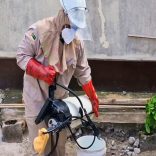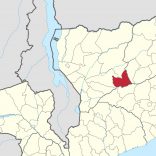Peace Corps to close country program in Mozambique
Manica misses rural water supply target

Women in Mozambique walking to collect water. Image: Courtesy of Water Aid / Helder Gudo (File photo)
The central Mozambican province of Manica has surpassed its target for urban water supply for the first six months of this year, but fell seriously short of the target for rural water sources.
According to the Provincial Director of Economy and Finance, Virgulino Nhate, speaking on Wednesday at a session of the Manica Provincial Assembly held in the district of Gondola, the target was 586 new urban connections to the water system. But in fact there were 827 new domestic connections – thus exceeding the target by more than 41 per cent.
However, the situation in rural Manica was very different. The government’s target was to drill 78 new boreholes for water supply between January and June, but only 19 were drilled (slightly less than 25 per cent of the target). 71 water sources were rehabilitated, which is 54 per cent of what had been planned.
Nhate did not give detailed explanations to explain why there had been such a serious shortfall in building new water sources in the rural areas, but he blamed the international financial crisis and last year’s low level insurrection by the rebel movement Renamo. He said that today 63 per cent of the Manica urban population has access to safe drinking water, but the figure falls to 58.1 per cent in the countryside.
“We had good results in the towns because we surpassed the target”, said Nhate. “We didn’t do well in the rural areas because factors such as political instability and the financial crisis in the country and the world hindered work in those areas. In some districts, the work did not happen because there were problems of moving into areas of the interior, because there was no security. But we have restarted the work and we believe that we have to improve in the second half of the year”.
Nhate’s excuses are unconvincing. Renamo leader Afonso Dhlakama declared a truce which took effect on 27 December. Since that date not a single Renamo attack has been reported in Manica or anywhere else in the country.
Also Read: About US$2.6 million needed to provide potable water for Inchope
As for sanitation, Nhate said the government, with the support of some of its partners, built 3,983 latrines out of the 4,500 planned for the first six months of the year – or only 88.5 per cent of the target.
“When we compare this with the first half of last year, when we built 1,974 latrines, we note a growth of 201.77 per cent”, said Nhate. “In this component we are satisfied, because we have guaranteed sanitation to people in both the cities and the rural areas”.
During the meeting, scheduled to last until Friday, the Provincial Assembly is analysing implementation of the government’s Economic and Social Plan and the 2017 state budget in the province, and considering the draft plan and budget for 2018.













Leave a Reply
Be the First to Comment!
You must be logged in to post a comment.
You must be logged in to post a comment.